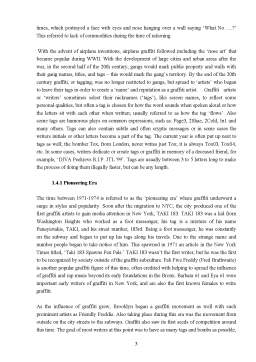Extras din proiect
Chapter one: Graffiti in time
‘There's no one history of graffiti. It depends
on what borough you lived in, what year you
were born in, and what lines you rode. The best
you will ever get is a personal history of graffiti.’
Haze
1.1 Introduction
In the first chapter of my certificate paper I thought to start whit how did all started and how far it will go. The history of graffiti has bred icons and pioneers that will likely be remembered by generations through word-of-mouth, with stories being passed on from one generation of writers to the next.
1.2 Etymology: What is graffiti?
Graffiti is a type of deliberately inscribed marking made by humans on surfaces, both private and public. Graffiti can also refer to website defacements; however, it usually takes the form of publicly painted art, drawings or words. When done without a property owner's consent it constitutes vandalism.
Graffiti is a style of art made on both public and private surfaces, prevalent in low income areas of cities, taking the form o f drawings, words, and art. Graffiti art is often considered vandalism because most of the time, the property’s owner is not consulted about the art administration. Graffiti art dates back to ancient classical Greece and the Roman Empire. The word Graffiti is a plural word derived from graffito, which refers to works of art created by scratching a design on a surface. The word graffito is also related to the word Graffiti in which it conveys a method of scratching through a layer of paint in order to reveal another pigmented layer below. All the words mentioned above are originally from the Italian language, and the main roots are graffiato which means “to scratch” and this word is from the Greek word graphein which means ‘to write’. It is still not clear when exactly the word graffiti was first used to distinguish an art form.
1.3 Ancient Graffiti- how did all started?
Historically, the term graffiti originally referred to the inscriptions, figure drawings, etc., found on the walls of ancient sepulchers or ruins. Usage of the word has evolved to include any decorations (inscribed on any surface) that one can regard as vandalism; or to cover pictures or writing placed on surfaces, usually external walls and sidewalks, without the permission of an owner. Thus, inscriptions made by the authors of a monument are not classed as graffiti.
Some people consider Palaeolithic rock art to be the first example of graffiti. As early as 30,000 B.C.E., humans have been etching and painting on public surfaces. Prehistoric petroglyphs, cave paintings, and pictographs commonly feature animals, humans, symbols, and daily-life objects. Although no one can determine exactly when and why these scenes and figures were painted, most academics agree that they were created either to enhance spiritual rituals or to chronicle daily life. Because these carvings and paintings were most likely permitted by other members of the society, some argue that this form of prehistoric art cannot be called graffiti.
Since there has been writing, humans have created graffiti. Graffiti has been found on the walls of Pompeii, in the catacombs of Rome, on the bases of Greek vases, on the faces of coins, on the Mayan temple walls of Tikal, and on early medieval Scandinavian church walls. In fact, it is from these ancient forms of public inscriptions that the word graffiti originated. Only recently has the word evolved to include the element of vandalism. Graffiti preserved at Pompeii has allowed archaeologists insight into the daily lives of people living during the first century. The graffiti ranges from political rhetoric and love declarations to magic charms and witty banter: ‘I wonder, O, wall, that you have not fallen in ruins from supporting the stupidities of so many scribblers.’ Archaeologists have also used ancient graffiti to study shifts in languages. The Romans carved graffiti into both their own walls and monuments and there are also, for instance, Egyptian ones. The graffiti carved on the walls of Pompeii were preserved by the eruption of Vesuvius and offer us a direct insight into street life: everyday Latin, insults, magic, love declarations, political consigns. One example has even been found that stated ‘Cave Canem’, which translates as ‘Beware of the Dog.
On the other hand, Viking graffiti can be found in Rome, and Varangians carved their runes in Hagia Sophia. Historic traveller graffiti can be found scribbled or etched onto the surfaces of famous heritage sites across the globe. During the early 1800’s, travellers, archaeologists, missionaries, and scholars etched their names onto temple walls across Egypt and Sudan. Another famous structure where you can find 18th and 19th century traveler writing is the Greek Temple of Poseidon at Sounion. Supposedly, you can find the English poet, Lord Byron’s name scratched onto one of the surviving columns.
1.4 Modern graffiti- How far can it go?
Throughout the 20th century, World War Two seemed to mark the real recognition of modern graffiti. ‘Kilroy was here’ became a popular cultural American expression in the form of graffiti; it depicted a doodle of Kilroy peeking over a wall. Similarly, Australians adopted a nation wide graffiti – ‘Foo was here’.
Preview document
Conținut arhivă zip
- Graffiti - More than Art.doc

























